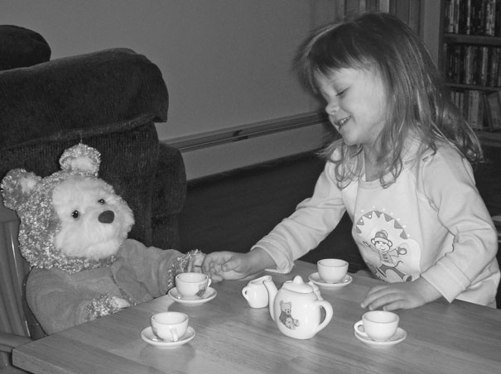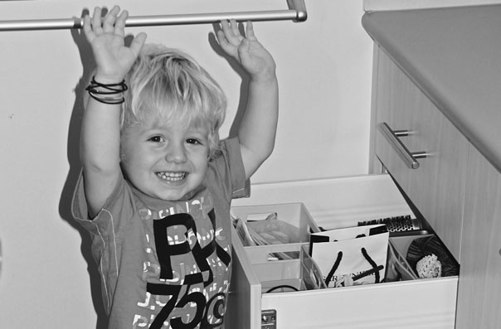The No-Cry Separation Anxiety Solution: Gentle Ways to Make Good-bye Easy from Six Months to Six Years (14 page)
Authors: Elizabeth Pantley
Tags: #0071596909

likely to resist and beg to stay home than one who is allowed a more
relaxed pace to his morning.
To make things easier, prepare as much as possible the night before
(set out clothes, pack lunches, set the breakfast table). Plan to get up
a bit earlier in the morning to allow an unhurried breakfast together.
Leaving sooner for daycare or school allows you to build in a little
extra time for dropping off, which means you can get your child set-
tled before you need to leave. A calm, peaceful morning sets your
child up to be more accepting of the day’s routine.
Encourage Your Child to Have
Positive Thoughts
Children with anxiety often dwell on their worries. Their thinking
becomes negative and infl exible, and they literally talk themselves
into feeling more and more anxious. Try to help your child be more
No-Cry Solutions for Preschool and School-Age Children
65
open-minded toward possible solutions in all areas of life, and this
will carry over into situations of separation anxiety.
To help a child think positively, avoid attacking his negative
thoughts or becoming angry with his pessimistic one-track mind. The
pressure to
stop
can often cause your child to try harder to convince
you of the validity of these thoughts. Instead, introduce new, posi-
tive thoughts without judging his previous negative ideas. Encourage
your child to look on the bright side and to search for solutions to his
dilemmas. Get him started by making positive suggestions and guid-
ing him to be more optimistic in the way he looks at life.
When your child is worried, it’s likely that his self-talk focuses on
possible disasters:
What if Mommy forgets to pick me up? What if I
get hurt and no one is here to help me? What if something bad happens
to Daddy while he is away?
A stressed-out child can rehearse these
thoughts in his mind over and over until he is overcome with fear
and worry. Negative self-talk begins on its own but easily escalates,
causing anxiety to increase. It takes practice for a child to change his
self-talk to more positive ideas.
The fi rst step is to help him understand that just because he
thinks something doesn’t make it real. To teach this, wait for a time
when your child is relaxed. Use an example to show how thoughts
are separate from reality. For example, thinking about a cow doesn’t
make one appear in the kitchen. Thinking about fl ying doesn’t cause
you to take off into the air. Then explain that this also applies to
fears, such as thinking that no one will arrive at pickup time or that
something bad will happen at preschool.
Professional-Speak
“When an anxious child becomes rigid in her thinking, she is
even more likely to be hobbled as she struggles to free herself
from her fears.”
—John S. Dacey, Ph.D., and Lisa B. Fiore, Ph.D., authors of
Your Anxious Child: How Parents and Teachers
Can Relieve Anxiety in Children

66 The No-Cry Separation Anxiety Solution
You can help your child remember positive thoughts by printing
helpful statements on index cards that can be carried in a pocket or
backpack. They can be messages such as these:
“Mom always picks me up after school.”
“I can do this.”
“Everything is okay.”
“If I feel nervous, I will take a deep breath, relax, and feel calm.”
Play the What-If Game
You can help your child develop more positive ways of thinking by
using the What-If game. This is intended to help your child fi gure
out in advance what she will do if things don’t go according to plan.
By planning this beforehand, your child’s stress and anxiety can be
greatly reduced.
Say, for example, that your child is afraid you won’t be there to pick
her up after school. First, let her know that this is highly unlikely,
Madison, two years old
No-Cry Solutions for Preschool and School-Age Children
67
and then (in a reassuring voice) say that even if it did happen, every-
thing would still be okay. Then play the What-If game by defi ning
your child’s concerns and outlining the most likely outcomes.
It may help for you to answer the questions fi rst, then ask the
questions a second time and let your child answer them. After some
practice, your dialogue might sound something like this:
Parent: I know that you worry that I won’t be there to pick you up
after school. Most likely, I will be there and everything will be fi ne.
But let’s play a What-If game. What if you come out of school and I
am not there?
Child: Then I could stand and wait fi ve minutes to see if you are late.
Parent: What if you wait fi ve minutes but I am still not there?
Child: Then I could go to the offi ce and ask if I can call you.
Parent: What if no one is in the offi ce?
Child: Then I can go to the health room and ask the nurse to use her
phone.
Parent: What if you call me and I don’t answer?
Child: Then I can call Dad on his cell phone.
A great children’s book series that parallels this kind of thought-
tracking process are the “If You Give” books written by Laura Joffe
Numeroff and illustrated by Felicia Bond. For example, in
If You Give
a Mouse a Cookie
, the little mouse fi rst asks for a cookie, which leads him to ask for a glass of milk. Then he looks in the mirror to see a
milk mustache, which leads him to ask for scissors to trim his hair,
and so on. You can read one or two of these entertaining books, then
introduce the What-If game to your child.
This game is a great way to show your child that it’s likely every-
thing will work out okay even if things don’t go exactly as planned.
It provides her with the idea that there is always another option to
fi nd. Finish the game with the reassurance that the What-If things
probably won’t happen, but if they do, she will be prepared.
68 The No-Cry Separation Anxiety Solution
Give More Choices
To give your child a sense of control, try to provide a few simple
choices leading up to any situation of separation: “Which jacket do
you want to wear today?” “Do you want to walk or ride our bikes to
school?” “Do you want two kisses and one hug, or two hugs and one
kiss?”
Give your child choices about the timing and amount of separa-
tion, if possible. Provide choices of babysitters when you can. Give
your child options about location, such as whether Grandma comes
to your home or he goes to hers. If he can customize his experience,
he may be more open to it.
Mother-Speak
“Our morning used to be fi lled with crying and complaining.
Now it’s fi lled with choices like, ‘What should we pack in your
lunch?’ ‘What shirt do you want to wear?’ and ‘Do you want to
take your book to school today?’ These simple choices keep
him moving forward. He almost seems to forget to worry!”
—Sofi e, mother of fi ve-year-old Jakob
Using Prayer to Help Your Child Cope
If your child says grace before dinner or bedtime prayers at night, you
can introduce a new, special prayer for those times when separation
anxiety hits. If you simply instruct him to remember to pray, it may or
may not be helpful, because it is unlikely he will be able to come up
with the right words under stress. It’s better to fi nd or create a prayer
that he can memorize or have written on an index card he can keep
in his pocket or backpack. You can use any prayer that helps your
child, but it should be positive and calming.
There are no rules when it comes to prayer, so it can help if you
make up your own verse to address your child’s actual concerns. Cre-
ate a simple rhyming verse that is easy for your child to memorize and
No-Cry Solutions for Preschool and School-Age Children
69
recite. Here’s one I made up for you; you can revise or edit it to suit
your child’s needs:
Please God be with me all day long.
Make me happy, keep me strong.
Hold my hand when I am scared
And let me know that you are there.
Keep me calm and safe today,
And chase all of my fears away.
Appreciate That It’s Not a Now-or-
Never Choice
Your child may not be comfortable attending events, such as play-
dates, camp, or birthday parties, and she may choose not to go. In
most cases, that’s really okay. There will be many opportunities for
your child to spend time with friends, go to parties, and participate
in other events away from home. Some tentative children will bypass
invitations and be perfectly content and comfortable with their deci-
sion to stay home. Typically, given enough time, most children will
outgrow this phase of separation anxiety and have plenty of experi-
ences away from home.
It is perfectly fi ne to avoid separating from your child during peak
phases of anxiety. It’s respectful of your child’s feelings and can be easier for all of you. It’s fi ne to take it slow, if you can, so that your
child can gradually mature toward independence on her own time-
table, with a little nudge of help from you.
Father-Speak
“Our daughter refused to attend parties, visit friends, or play
Little League until she was nine years old. Then the dam broke
and now she’s become a regular social butterfl y. I can barely
keep up with her schedule!”
—Mark, father of ten-year-old Felicity
70 The No-Cry Separation Anxiety Solution
Allow Your Child to Bring Something to the
Host, Teacher, or Caregiver
If you can encourage your child’s relationship with an alternative care-
giver, you make it easier for her to stay alone with that person. One way
to encourage this connection is to have your child bring a book from
home to share or deliver a plate of cookies or a fl ower to the caregiver.
Sharing something with the adult in charge allows an encouraging
exchange and creates positive momentum for their time together.
Let Your Child Leave You, Instead of You
Leaving Him
Some children prefer to be the ones who walk away in a separation
situation. They fi nd it easier to leave than to watch you retreat and
walk away from them. It may help to fi nd something interesting and
distracting to pull your child’s attention off the separation and focus
it on the event. Point your child in the direction of something fun,
say a quick good-bye, and let him walk away from you.
Talk to the Teacher or Caregiver
Most professionals are experts when it comes to dealing with separa-
tion anxiety. Ask for a meeting to discuss your concerns, and come
prepared with a list of concerns and possible solutions. Don’t talk in
front of your child or when the teacher is busy tending to other chil-
dren or class responsibilities. It’s better to ask ahead for an appoint-
ment to have a private discussion.
Don’t Show Your Annoyance, Frustration,
or Worry
It can be frustrating when your child won’t go willingly to daycare,
school, or a babysitter. It can be worrisome if your child screams
because a relative attempts to pick her up or because you’ve left the

No-Cry Solutions for Preschool and School-Age Children
71
Balin, twenty-one months old
